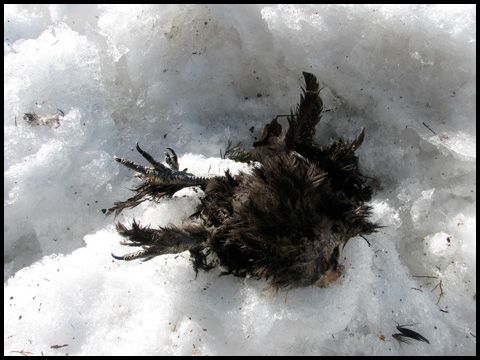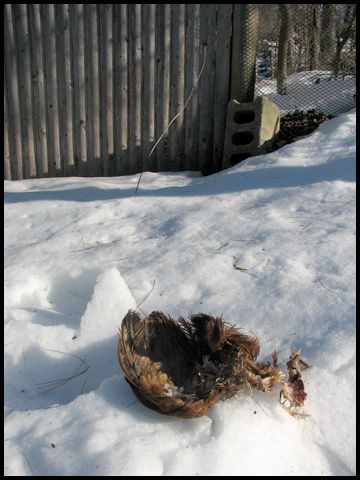100 Species #3: Domestic chicken

Domestic chicken Gallus gallus domesticus
You may recall that a couple weeks ago we encountered a loose rooster in our neighborhood. I strongly suspected it was an abandoned animal, and contacted the Animal Rescue League. We didn't see it again, so figured they must have captured it. Not so.
In a coincidence that would alarm and disturb a superstitious person, the rooster met a violent death and its carcass ended up in our yard. Alexis found a wing first (or rather, Maggie did) and then I found another. Only much later did we find the big piece with legs attached, above.

Chickens were once commonly kept on residential property in the United States. They can convert cheap table scraps and corn into eggs and meat, on a small plot of land. The prosperity following the Second World War, and the status-seeking culture of the sixties changed the relationship between Americans and their food-producing animals. Eggs could be obtained cheaply from massive poultry operations shipping their product directly to supermarkets, and keeping livestock became something "country" people did.
Various social forces are reversing the trend somewhat, with some municipalities allowing small amounts of chickens to be kept in cities and towns. In other places local food advocates fight for the right to keep chickens against town hall or the neighborhood association. Opponents to the practice list pests, disease, smell, and noise as reasons against chickens in residential settings. At the Animal Rescue League, they told us that while chickens are allowed in Dedham (following a permitting process) that roosters (who famously utter their territorial song in the early morning when it's still dark out) had recently been banned, and as a result they were seeing an increase in abandoned male chickens.
The day after we found the chicken parts there was a light snow, and we could track several animals through our back yard. A domestic cat crossed by the shed, a gray squirrel kept to the saplings by the retaining walls, and a loose dog (not on leash--no human tracks nearby) left a set of tracks. Between the body and the wings we found a set of tracks that were indistinct, but in a clear pattern. The pattern and size were consistent with a fisher, the largest weasel species in New England. The next day both wings and the carcass were gone.